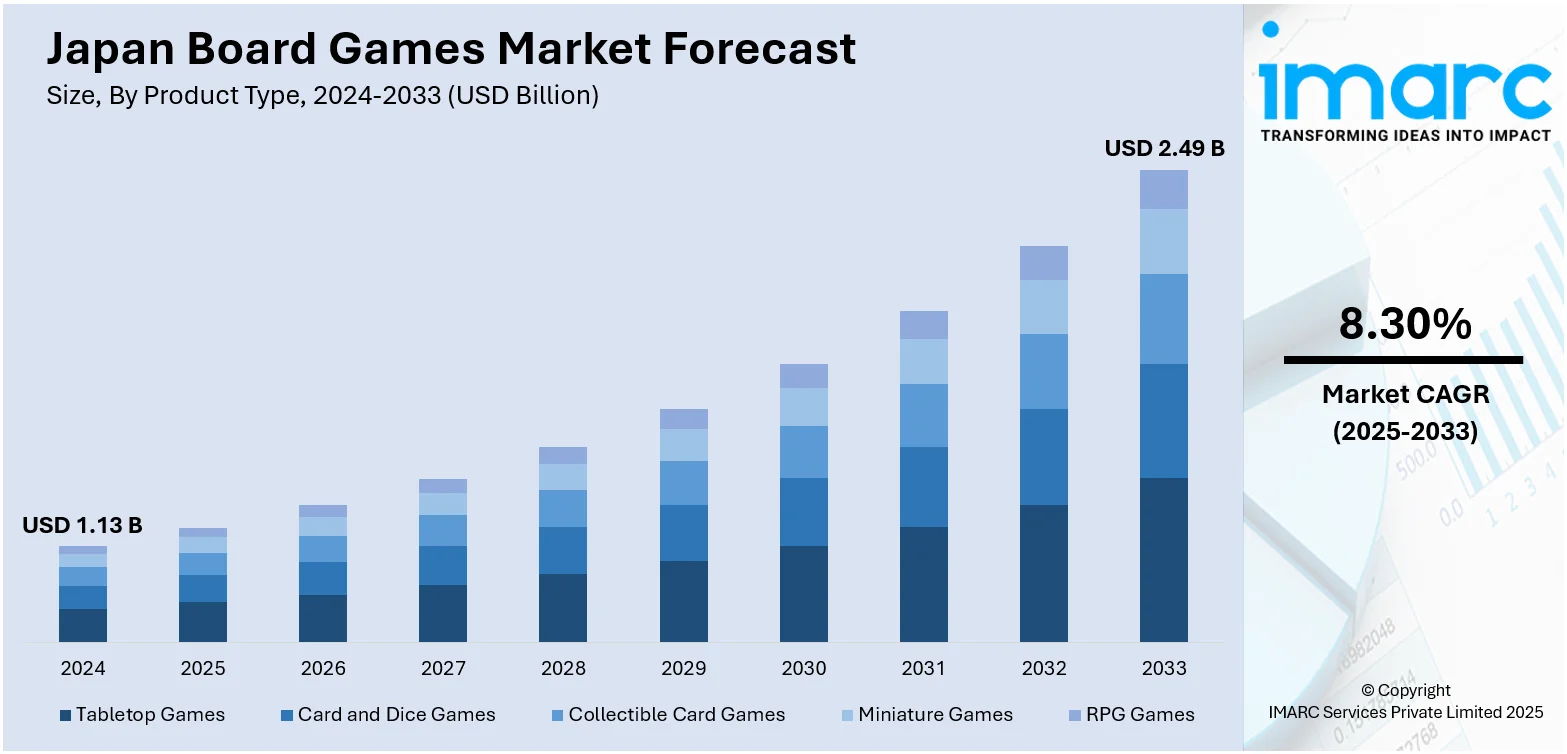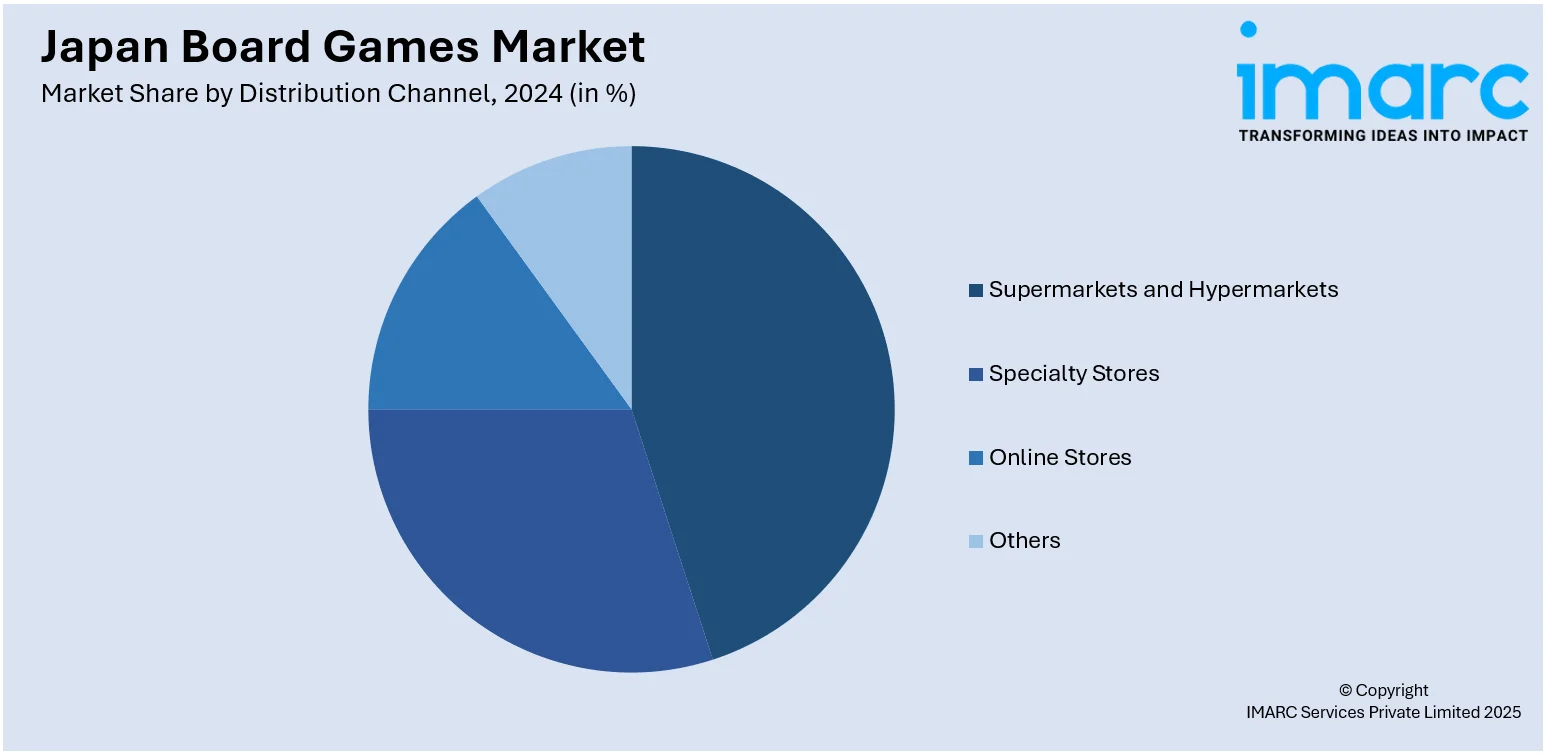
Japan Board Games Market Size, Share, Trends and Forecast by Product Type, Game Type, Age Group, Distribution Channel, and Region, 2025-2033
Japan Board Games Market Overview:
The Japan board games market size reached USD 1.13 Billion in 2024. Looking forward, IMARC Group expects the market to reach USD 2.49 Billion by 2033, exhibiting a growth rate (CAGR) of 8.30% during 2025-2033. The board game market in Japan benefits from growing e-commerce access, direct sales channels, and strong pop culture partnerships. Online retail broadens reach and convenience, while themed collaborations attract new audiences, boost collectability, and strengthen community engagement across diverse user groups, contributing to the expansion of the Japan board games market share.
|
Report Attribute
|
Key Statistics
|
|---|---|
|
Base Year
|
2024 |
|
Forecast Years
|
2025-2033
|
|
Historical Years
|
2019-2024
|
| Market Size in 2024 | USD 1.13 Billion |
| Market Forecast in 2033 | USD 2.49 Billion |
| Market Growth Rate 2025-2033 | 8.30% |
Japan Board Games Market Trends:
Expansion of E-Commerce Channels and Direct-to-Consumer (DTC) Sales
A significant factor supporting the growth of Japan’s board game market is the rapid expansion of the country’s e-commerce sector, which reached USD 258.0 billion in 2024 and is projected to grow to USD 692.8 billion by 2033, reflecting a CAGR of 11.02% during 2025–2033. This rise in digital retail infrastructure enables publishers, specialty retailers, and independent designers to connect with players nationwide without relying solely on traditional brick-and-mortar distribution networks. Many local hobby stores and small creators now operate dedicated online storefronts or utilize established marketplaces to offer exclusive releases, limited-edition bundles, and direct pre-orders that broaden their reach beyond local user bases. Individuals benefit from convenient access to a diverse range of products, fast delivery, and opportunities to support niche and independent creators regardless of their location. Integration of social media marketing and influencer engagement further streamlines the path from product discovery to purchase, driving impulse buying and strengthening community ties. Crowdfunding campaigns and online-exclusive launches are also becoming a viable channel for testing innovative game concepts with reduced financial risk.

To get more information on this market, Request Sample
Influence of Pop Culture Collaborations and Themed Releases
Collaborations with popular cultural icons and well-known creative brands are becoming a crucial factor in propelling the Japan board games market growth. When established studios, designers, or entertainment franchises lend their storytelling and artistic style to board game projects, they draw in both dedicated hobbyists and fans who may not usually engage with tabletop gaming. Such themed releases often carry a sense of exclusivity and nostalgia that encourages impulse purchases and collecting. Well-crafted tie-ins also expand the audience by appealing to families, casual players, and gift buyers who value recognizable characters and familiar worlds. Creative collaborations often lead to distinctive game mechanics or artwork that stand out amid generic offerings, giving retailers fresh content to promote throughout the year. This approach generates considerable media attention, strengthens word-of-mouth marketing, and creates lasting engagement well beyond the initial launch window. Limited-edition runs, special packaging, and promotional materials further increase the demand, as collectors and enthusiasts compete to secure unique items. By merging beloved cultural touchstones with quality gameplay, themed projects are offering a reliable path for publishers to tap into broader user groups and sustain steady interest. For example, in 2024, Studio Ghibli released a free printable board game styled as a poster for Ghibli Park, designed by Goro Miyazaki. The game was a sugoroku-style adventure through the park with charming illustrations and references to beloved Ghibli films.
Japan Board Games Market Segmentation:
IMARC Group provides an analysis of the key trends in each segment of the market, along with forecasts at the country and regional levels for 2025-2033. Our report has categorized the market based on product type, game type, age group, and distribution channel.
Product Type Insights:
- Tabletop Games
- Card and Dice Games
- Collectible Card Games
- Miniature Games
- RPG Games
The report has provided a detailed breakup and analysis of the market based on the product type. This includes tabletop games, card and dice games, collectible card games, miniature games, and RPG games.
Game Type Insights:
- Strategy and War Games
- Educational Games
- Fantasy Games
- Sport Games
- Others
A detailed breakup and analysis of the market based on the game type have also been provided in the report. This includes strategy and war games, educational games, fantasy games, sport games, and others.
Age Group Insights:
- 0-2 Years
- 2-5 Years
- 5-12 Years
- Above 12 Years
The report has provided a detailed breakup and analysis of the market based on the age group. This includes 0-2 years, 2-5 years, 5-12 years, and above 12 years.
Distribution Channel Insights:

- Supermarkets and Hypermarkets
- Specialty Stores
- Online Stores
- Others
A detailed breakup and analysis of the market based on the distribution channel have also been provided in the report. This includes supermarkets and hypermarkets, specialty stores, online stores, and others.
Regional Insights:
- Kanto Region
- Kansai/Kinki Region
- Central/ Chubu Region
- Kyushu-Okinawa Region
- Tohoku Region
- Chugoku Region
- Hokkaido Region
- Shikoku Region
The report has also provided a comprehensive analysis of all the major regional markets, which include Kanto Region, Kansai/Kinki Region, Central/ Chubu Region, Kyushu-Okinawa Region, Tohoku Region, Chugoku Region, Hokkaido Region, and Shikoku Region.
Competitive Landscape:
The market research report has also provided a comprehensive analysis of the competitive landscape. Competitive analysis such as market structure, key player positioning, top winning strategies, competitive dashboard, and company evaluation quadrant has been covered in the report. Also, detailed profiles of all major companies have been provided.
Japan Board Games Market News:
- In January 2025, Bandai Spirits in Japan announced Gundam Assemble, a new tabletop miniatures game featuring 5 cm Gunpla models from the iconic Mobile Suit Gundam franchise. The game allows players to recreate or remix battles using unit-specific abilities. More details will be released soon via the official Gundam Assemble website.
- In January 2024, Banana Moon Games announced they would exhibit at the Board Game Business Expo Japan on March 23-24, 2024, at INTEX Osaka. They showcased their Bossa series, Pipo – The Innocent Aliens, and introduced their new game, GACHIJO, which was scheduled for crowdfunding in March or April 2024. The expo featured various editions and expansions of their popular games.
Japan Board Games Market Report Coverage:
| Report Features | Details |
|---|---|
| Base Year of the Analysis | 2024 |
| Historical Period | 2019-2024 |
| Forecast Period | 2025-2033 |
| Units | Billion USD |
| Scope of the Report |
Exploration of Historical Trends and Market Outlook, Industry Catalysts and Challenges, Segment-Wise Historical and Future Market Assessment:
|
| Product Types Covered | Tabletop Games, Card and Dice Games, Collectible Card Games, Miniature Games, RPG Games |
| Game Types Covered | Strategy and War Games, Educational Games, Fantasy Games, Sport Games, Others |
| Age Groups Covered | 0-2 Years, 2-5 Years, 5-12 Years, Above 12 Years |
| Distribution Channels Covered | Supermarkets and Hypermarkets, Specialty Stores, Online Stores, Others |
| Regions Covered | Kanto Region, Kansai/Kinki Region, Central/ Chubu Region, Kyushu-Okinawa Region, Tohoku Region, Chugoku Region, Hokkaido Region, Shikoku Region |
| Customization Scope | 10% Free Customization |
| Post-Sale Analyst Support | 10-12 Weeks |
| Delivery Format | PDF and Excel through Email (We can also provide the editable version of the report in PPT/Word format on special request) |
Key Questions Answered in This Report:
- How has the Japan board games market performed so far and how will it perform in the coming years?
- What is the breakup of the Japan board games market on the basis of product type?
- What is the breakup of the Japan board games market on the basis of game type?
- What is the breakup of the Japan board games market on the basis of age group?
- What is the breakup of the Japan board games market on the basis of distribution channel?
- What is the breakup of the Japan board games market on the basis of region?
- What are the various stages in the value chain of the Japan board games market?
- What are the key driving factors and challenges in the Japan board games market?
- What is the structure of the Japan board games market and who are the key players?
- What is the degree of competition in the Japan board games market?
Key Benefits for Stakeholders:
- IMARC’s industry report offers a comprehensive quantitative analysis of various market segments, historical and current market trends, market forecasts, and dynamics of the Japan board games market from 2019-2033.
- The research report provides the latest information on the market drivers, challenges, and opportunities in the Japan board games market.
- Porter's five forces analysis assist stakeholders in assessing the impact of new entrants, competitive rivalry, supplier power, buyer power, and the threat of substitution. It helps stakeholders to analyze the level of competition within the Japan board games industry and its attractiveness.
- Competitive landscape allows stakeholders to understand their competitive environment and provides an insight into the current positions of key players in the market.
Need more help?
- Speak to our experienced analysts for insights on the current market scenarios.
- Include additional segments and countries to customize the report as per your requirement.
- Gain an unparalleled competitive advantage in your domain by understanding how to utilize the report and positively impacting your operations and revenue.
- For further assistance, please connect with our analysts.
 Request Customization
Request Customization
 Speak to an Analyst
Speak to an Analyst
 Request Brochure
Request Brochure
 Inquire Before Buying
Inquire Before Buying




.webp)




.webp)












